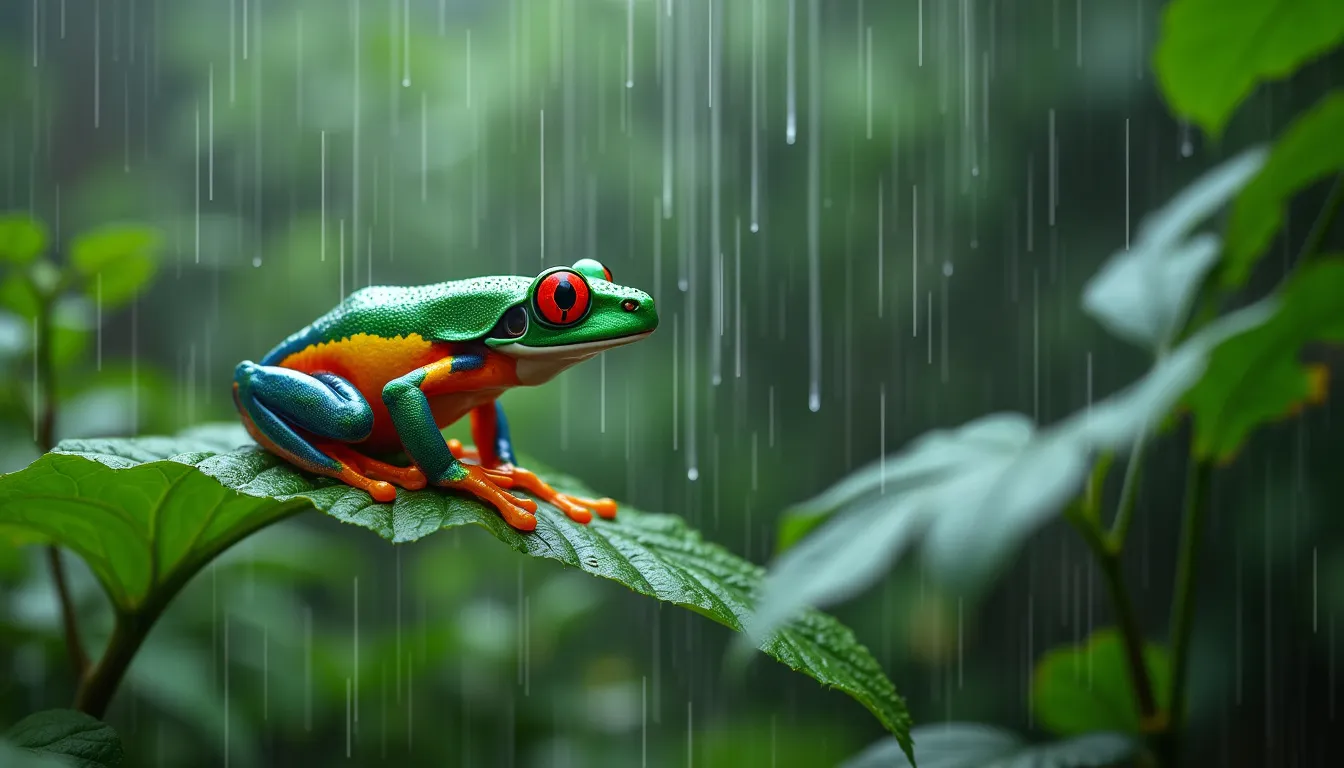
Understanding Tree Frog Seasonal Behavior
Have you ever paused to listen to the charming serenade of tree frogs during a warm summer night? These little croakers might just seem like your average amphibians, but their seasonal behavior is a world of wonder! In this article, we dive deep into the fascinating realm of tree frog seasonal behavior. Understanding these behaviors enriches our knowledge and highlights the intricate relationships between these creatures and their environment.
From the way temperature, humidity, and light can trigger changes in their actions, to the lifestyle adaptations they make during different seasons, we’ll cover it all. Plus, we’ll explore their unique breeding patterns, feeding habits, and how they survive through uncomfortable seasons. So, if you’re ready to leap into this exciting exploration of tree frog seasonal behavior, keep reading! You might just discover why these little critters deserve their spotlight in the world of amphibians.
A. Definition and Importance of Seasonal Behavior in Tree Frogs
Tree frog seasonal behavior refers to the various changes and adaptations that tree frogs go through in response to shifting environmental conditions throughout the year. Understanding this behavior is critical, as it provides insights into their survival strategies, mating patterns, and the overall health of their ecosystems.
1. Adaptive Strategies: The ability to adapt to seasonal changes helps tree frogs optimize their chances for survival. For example, in cold climates, certain species enter hibernation during the winter months. In contrast, during warmer months, they may become more active and engage in mating rituals.
2. Ecological Importance: Tree frogs play a significant role in their ecosystems. They are both predators and prey, making their seasonal behavior crucial for maintaining a balanced food web. These amphibians help control insect populations and serve as an essential food source for various predators.
3. Research Insights: By studying tree frog seasonal behavior, researchers can better predict how environmental changes, such as climate change and habitat destruction, may impact these fascinating creatures.
B. Overview of the Article’s Focus on Tree Frog Seasonal Behavior
This article will delve into the various aspects of tree frog seasonal behavior to provide a comprehensive understanding:
– Factors Influencing Seasonal Behavior: We will explore the environmental cues that trigger seasonal changes, including how elements like temperature, humidity, and photoperiod have a profound impact on their habits.
– Manifestations of Seasonal Behavior: We will also investigate the concrete manifestations of tree frog seasonal behavior, focusing on their breeding patterns, feeding habits, and strategies like hibernation and aestivation.
By breaking down these elements, this article aims to shed light on how tree frogs navigate the yearly cycles and challenges they face, demonstrating the interplay between their biology and the environment.
In summary, tree frog seasonal behavior is an essential concept for understanding not just these amphibians, but the broader ecosystem in which they thrive. Stay tuned as we jump into the next section, where we will investigate the factors that influence this fascinating behavior!

Factors Influencing Tree Frog Seasonal Behavior
Tree frog seasonal behavior is not just a random series of hops and croaks; it’s a complex dance influenced by several key factors that intertwine the frog’s life with the changing seasons. Understanding these factors is vital for anyone curious about our amphibious friends. Here’s a closer look at what drives tree frogs to behave the way they do throughout the year.
A. Environmental Cues That Trigger Seasonal Changes
- Light Levels: As daylight savings time rolls around, tree frogs receive new cues from their environment. Many species rely on longer days to kick off their breeding behaviors in spring.
- Seasonal Rainfall: Rainy seasons often awaken tree frogs from their slumber, signaling that it’s time to mate and feast. These amphibians are sensitive to moisture levels, prompting them to emerge from hiding as puddles form.
- Sound Cues: Male tree frogs often call to each other to establish territory or attract mates. The chorus of croaks can indicate that it’s peak breeding season, as these vocalizations ramp up with warmth and moisture.
B. The Role of Temperature, Humidity, and Photoperiod
The three dynamic variables of temperature, humidity, and photoperiod (the amount of daytime) essentially make the world go ‘round for tree frog seasonal behavior. Let’s break down their significance:
| Factor | Influence on Tree Frogs |
|---|---|
| Temperature | Tree frogs bask in warm temperatures that signal it’s time to breed. They tend to become sluggish when the cold hits, often seeking refuge. |
| Humidity | High humidity levels not only help keep tree frogs hydrated but also coincide with breeding seasons when they are most active. |
| Photoperiod | Longer days after winter tend to correlate with the onset of mating activities and feeding frenzies! |
As you can see, the intersection of these variables significantly shapes tree frog seasonal behavior. They’re not just reactively hopping along; these variables synchronize their biological clocks.
C. The Impact of Habitat Quality and Availability on Behavior
Now, let’s talk about the real estate aspect of tree frog life! Quality habitats are paramount, and they play a vital role in seasonal behavior:
- Breeding Sites: A healthy aquatic environment is key. Availability of clean water bodies with proper vegetation influences where tree frogs choose to breed during the spring and summer months.
- Food Resources: The abundance of insects and other prey directly affects feeding behavior. A rich habitat means higher chances of survival and less competition for food.
- Microhabitats: Tree frogs often rely on rotting logs, leaf litter, and dense vegetation for shelter. Poor habitat conditions lead to stress and disrupted seasonal behaviors.
Tree frog seasonal behavior is, therefore, intertwined with the quality of their habitat. If conditions are poor, it affects their breeding success, feeding habits, and even their survival. A thriving ecosystem is crucial for maintaining these fascinating amphibians.
To learn more about the impact of environmental factors on other animals, check out resources like Nature and PubMed Central for academic insights.
In conclusion, understanding the factors influencing tree frog seasonal behavior helps in appreciating the intricate relationships they have within ecosystems. From environmental cues to habitat quality, each aspect plays a significant role in how these frogs thrive and adapt throughout the year.

Manifestations of Tree Frog Seasonal Behavior
Tree frogs are fascinating creatures that exhibit a variety of behaviors in response to seasonal changes. From their enchanting breeding rituals to their unique feeding habits and survival strategies, these behaviors are a fundamental aspect of understanding tree frog seasonal behavior. Let’s break down some of the key manifestations of this behavior.
A. Breeding Patterns and Mating Rituals Throughout the Seasons
Breeding is arguably one of the most visible manifestations of tree frog seasonal behavior. Here’s how tree frogs get their groove on during different seasons:
- Spring: The most active breeding season. Males often engage in loud croaking contests to attract females. The chorus of calls can be quite loud, turning ponds into a nature concert!
- Summer: After successful mating in spring, egg laying usually occurs in warm, shallow waters. Some species might have multiple breeding cycles throughout the summer.
- Fall: Breeding activities may start to decline as temperatures drop, and the focus shifts to finding food and preparing for the colder months ahead.
The breeding habits vary widely between species, but the excitement and competition among males to claim their territory and attract females are apparent in most cases!
B. Changes in Feeding Behavior and Diet in Different Seasons
The diet of tree frogs changes throughout the year, heavily influenced by seasonal availability. Here’s how tree frog seasonal behavior impacts their feeding:
| Season | Dietary Habits |
|---|---|
| Spring | Insects abound! Tree frogs feast on a variety of bugs that emerge as temperatures rise. |
| Summer | Daytime feeding is common, with tree frogs hunting for beetles, flies, and moths. |
| Fall | As temperatures drop, the feeding may slow down; frogs will stock up on calories! |
| Winter | Most tree frogs either hibernate or enter a state of dormancy, thus significantly reducing their need for food. |
Tree frogs are opportunistic feeders, meaning they adapt their diets based on what is available during the changing seasonal periods. Their keen sense of the environment allows them to thrive!
C. Hibernation and Aestivation Strategies Employed by Tree Frogs
When it comes to adapting to harsh weather, tree frogs demonstrate two major strategies: hibernation and aestivation.
Hibernation: This occurs in colder climates where tree frogs face freezing temperatures. They usually find a sheltered spot, often underground or under leaf litter, and enter a state of reduced metabolism. Here’s what you should know:
- Tree frogs can survive freezing conditions thanks to special proteins that protect their cells.
- During hibernation, heart rates drop significantly, and they rely on stored energy.
Aestivation: In contrast, aestivation is a strategy used during extremely hot and dry conditions, typically in summer. Here’s how it works:
- Tree frogs burrow into the ground or seek shelter to avoid dehydration.
- They enter a state of torpor, significantly slowing their metabolism, which conserves energy and water.
Both hibernation and aestivation are vital for the survival of tree frogs and are direct responses to the changing environmental conditions tied closely to tree frog seasonal behavior.
Conclusion
The seasonal behavior of tree frogs is a dynamic aspect affecting every facet of their life. From breeding patterns to diet and survival techniques, understanding these seasonal changes can help in the conservation and study of these remarkable amphibians. Curious to learn more about tree frogs? Check out articles from the Amphibians Specialist Group for exciting insights!
Understanding tree frog seasonal behavior is crucial not only for the conservation of these fascinating amphibians but also for appreciating their unique adaptations to the ever-changing environment. By recognizing the various environmental cues that influence their behavior—ranging from temperature and humidity to the critical quality of their habitats—we can better comprehend how these vibrant creatures navigate their lives across different seasons.
Their intricate breeding patterns, varied feeding habits, and strategic hibernation or aestivation techniques illustrate the remarkable resilience and adaptability of tree frogs. As we continue to study and protect these species, we ensure that future generations can marvel at their captivating seasonal behaviors. So, the next time you leap into a pond or spot a tree frog perched on a branch, you’ll have a deeper appreciation for the seasonal dance they perform each year. Studying tree frog seasonal behavior not only enriches our knowledge of biodiversity but also highlights the need for ongoing conservation efforts to preserve these delicate amphibious ecosystems.
